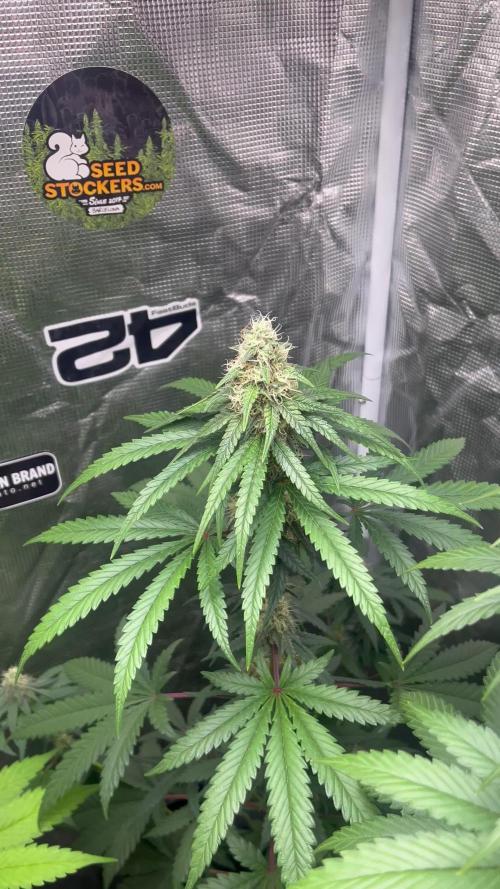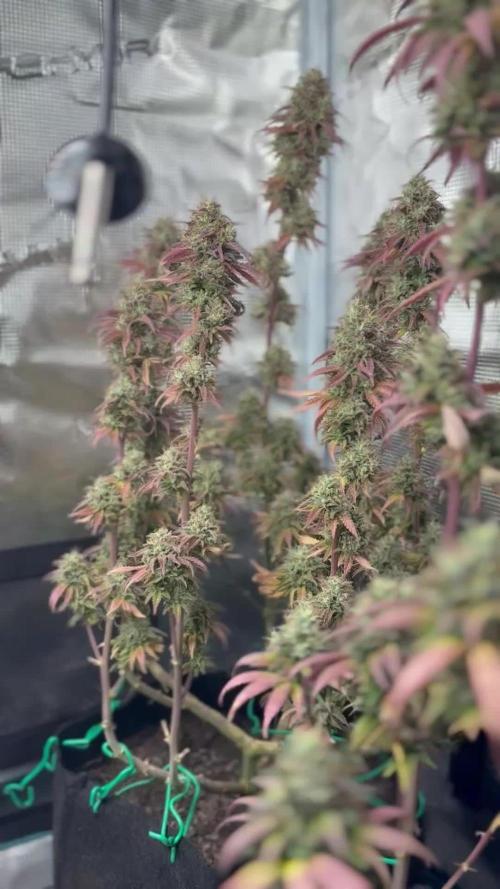The Grow Awards 2026 🏆 



























Likes
Comments
Share


@VeeDro203
Follow
These 2 have slightly different structures. One more purple and heavy jelly smell! The other a lot more pale green purple and a creamy jelly smell. Similar to one of my Miami Miami with the cream
Likes
52
Share


@HazeyBobby
Follow
The week ends Sunday Mar-1, being day 61 of flowering since flipping the light. From first pistils shown, it's day 45 which is a more accurate snapshot of where the plants actually are in their maturity.
The buds development is progressing albeit slowly and trichomes are still clear across the canopy with lots of frost on the sugar leaves.
The buds have beautiful structure and quite fluffy. Swelling has started on some calyxes.
Light is maintained at 30cm above the canopy, with single daily fertigation at lights on - watering 3L per day. Fertigation pH target is 5.9-6.2 whilst flowering. Stopped the practice of fertigating at lights off due to the springtales infestation. Need to allow at least 2-4hrs of lights on period after fertigation. The coco is not dry but still damp on the surface after 24hrs from fertigation.
Trying to maintaining an average RH in the space at 50% but it's getting harder now with all flowers.
-----------------------------------------------------------------------------------------------------------------------------------------------------------------------------------------------------------------------
The grow setup includes;
- Secret Jardin DS120W tent (120cm x 60cm x 180cm) placed inside the bedroom. Passive & active intake of air is from a closed off section of the room where the central heating boiler sits - the intake is warm air (20 degC.) and fairly dry (40% RH) during the winter months.
- Mars Hydro SP250 LED light
- extraction fan - AC Infinity Cloudline T6
- ventilation fans
- aquarium heater
- small oil heater
- small dehumidifier
- 20L Airpots and 3.5L general pots for seedling stage
- Canna Coco substrate and nutrients
- GHE Flora trio nutrients
- pH and EC/TDS meters
- 2x Govee Thermo/Hygro meters (one at canopy the other at the roots level)
Likes
119
Share


@DogDoctorOfficial
Follow
Time to give this P2000 a secont run, and in it i will run a single clone that i took from my previous run, i took one from each phenotype and from them i chose the one i like the most in terms of plant structure , terpene profile and in the end smoke test also, that one is the most important one lol and the one with the most value on my decision, saying this dont judge me on this hahahaha i kind a forget it in the corner and now its time to bring her up to her full potential.
I started by transplanting her from her tinny pot to a 25 L one , had to the soil 100g of All in one Pellets, a touch of microbial life and some Mycor to the roots and ready she is, gave them a foliar feeding with APTUS HOLLAND nutrispray and gave them a full feeding with the on the water sine the pallets will take a couple days minimum to start breaking and becoming available for the plants to take, i will let her adapt to it all for now and then i will star training her to became a tiny ginormous beautiful lady best, covered in trichomes and smelling like pines falling out of pine trees in the middle of the woods.
As for the PAR department for now i am giving them 600 PPFD and running my VIPARSPECTRA P2000 @ 69%
Looking at them an i decided that it was a good idea to start some training going on in this girl, so i gave her a new look and lets see how she goes from here, i spray them again with APTUS HOLLAND Nutrispray to help thing move faster .
And they are coming back to life , in just a couple of days i can notice that they love the fact that im giving them my love and attention
Is it just me or they are bouncing back fast af ? Not complaining at all hehehe , did some more training today, if they keep evolving like this i will be able soon to start taking leafs and selecting what to keep and what have to go.
Just recently started collaborating with APTUS HOLAND and i have to give a big shoutout to them ,Thank you Aptus Holland for believing in my love for growing , fells amazing wen you already believe and buy a product and they come and start supporting your love for it all 🙏🙏🙏💚💚💚🙌🙌🙌✊✊✊
As always thank you guys for your love , your time, your support and it all, i fell blessed and i am truly thankful 💚💚💚🙏🙏🙏🙌🙌🙌
Let the games begin hihihihi
All i grow is medicine for myself, for me and for my best friend with is me 😆 nothing to sell, so don’t even ask 😅💚💚💚
All info and full product details can be find in can find @
https://viparspectra.eu/collections/grow-lights DISCOUNT CODE 5% - DOGDOCTOR ( all store )
https://www.zamnesia.com DISCOUNT CODE 10% - GROWITGD ( just for seeds )
https://aptus-holland.com/
#aptus #aptusplantteck #aptusgang #aptusfamily #aptustrueplantscience #inbalancewithnature #trueplantscience #viparspectra #zamnesiaseeds #growerslove
With true love comes happiness 💚🙏 Always believe in your self and always do things expecting nothing and with an open heart , be a giver and the universe will give back to you in ways you could not even imagine so 💚💚💚
More info and updates @
https://growdiaries.com/grower/dogdoctor
https://instagram.com/dogdoctorofficial
https://youtube.com/channel/UCR7ta4DKLFMg2xxTMr2cpIg
💚💚💚Growers love to you all 💚💚💚
Likes
2
Share


@eldruida_lamota
Follow
Vamos familia, actualizamos la quinta semana de floración de estas Runtr de MSNL.
La temperatura que estuvo entre los 24-26 grados y humedad dentro de los rangos correctos.
En cuanto a las plantas las veo verde sano, estiraron bien y ensancharon bastante también.
Se nota que los nutrientes de la marca Agrobeta, añadí Thor y Mega Pk, hacen sus funciones.
Las flores empezaron a engordar y a llenarse de tricomas, por el momento todo correcto, os dejé también alguna novedad y un cambio en la sala, agradecer al equipo de Mars hydro por el nuevo TSW2000. (los últimos 5 años cultive solo con los leds de esta marca).
- os dejo por aquí un CÓDIGO: Eldruida
Descuento para la tienda de MARS HYDRO.
https://www.mars-hydro.com
Hasta aquí todo, Buenos humos 💨💨💨
Likes
7
Share


@Mr_nugs_lover_David
Follow
The ladies are opening up nicely after 48hs of planted (2 days) as normal, the pheno #1 has opened first let's see how they keep developing!
Likes
15
Share


@Drtomb
Follow
It's been a long minute since I've grown chocolopez.. Or as I like to call her Choco Lopez. I recall her being a very fruitful bud. Very sativa and not super dense buds. Delicious chocolate tastes.
Ive never grown this out as a full screen before. Stay tuned.
Ive been vegging these girls for about 5 weeks as the gorilla glue 4 was a week longer then expected.
These have all been topped to 3 tops for a grand total of 27 tops. Leveled the canopy to 18" tall and moved them into flower.
Likes
2
Share


@R_atata
Follow
Die Dos Si Dos sieht so unverschämt gut aus. Und das obwohl sie erst 8 Wochen alt ist. Der Geruch ist schon ausgeprägt. Bisher zeigt sie aber kein besonderes Terpenprofil. Die Lemon Haze zeigt eindrucksvoll ihre Sativa-Seite und legt ein starkes Längenwachstum hin. Es ist spannend zu sehen, wie sich die unterschiedlichen Genetiken bei gleichen Bedingungen verhalten.
Likes
11
Share


@Neo4422
Follow
Day 98
They doing fine. The slow girl is getting interesting. Her frostiness is changing suddenly and getting thicker in this two days.
Likes
12
Share


@HIAZ_urbanbudfarmer
Follow
This girl was a fast finisher harvested on day 46 of flower, nearly 7 full weeks.
Likes
4
Share


@BiggieDy
Follow
On the 7th week of flowering, I started rinsing. PH 6.3
The buds are very hard and icy.
the total round is rated 8/10 a buds 10/10
I had a 2 day problem with PH.
Next week it looks like a harvest, but I'll see by the resin.
Likes
3
Share


@CannaNibal
Follow
This project is kind of experiment with e-bay cheap led 150w ufo light.
Week two, to be honest wasn't so spectacular, but I found out that plant was developing it's root system ( i'll try to post picture of roots next time). Week three went surprisingly well, the plant grown over twice of it's last week size.
I'm looking forward for next week effects - the cheapo light with DWC system may bring some spectacular results.
Likes
23
Share


@SwabianMadness
Follow
Have 246 Gram of dry Buds. Was an Act to trim all this. With first two i got help from my Girl. And the third i did alone
Likes
2
Share


@kanabise
Follow
De jolie couleur violette et la tête devienne très grosse mais pas beaucoup dense
Likes
3
Share


@velouria
Follow
Week 8! I defoliated this plant finally. It took quite a while to even go into flowering (wasn't until the 7th week), so I'm hoping I didn't defoliate too soon. Ton of little bud sites now visible. I'm so curious how it's going to mature.
Mix of thunderstorms and bright sun here. It's probably getting less light than it should because I'm keeping it under the roof a lot of the day.
































